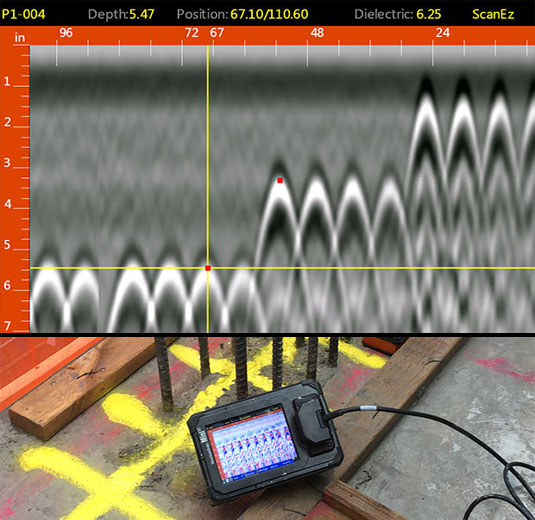Secret Benefits of Using Concrete Scanning Innovation
Wiki Article
Unveil the Transformative Power of Concrete Scanning in Taking Full Advantage Of Effectiveness and Safety
Concrete scanning has actually emerged as an important device in the construction market, using unequaled benefits in boosting task effectiveness and guaranteeing security requirements. By utilizing advanced technology, concrete scanning permits specialists to see past the surface, uncovering hidden intricacies that might impact the architectural honesty of a structure. The transformative power of concrete scanning hinges on its ability to offer real-time data and comprehensive insights, transforming exactly how projects are planned and performed. As we explore the details of this innovative strategy, a globe of possibilities opens up, showcasing a new era of construction methods that focus on accuracy and safety and security.Value of Concrete Scanning
Guaranteeing the architectural integrity and safety and security of building tasks starts with the vital action of carrying out thorough concrete scanning. Concrete scanning is a non-destructive approach made use of to discover and map subsurface aspects within concrete structures.The significance of concrete scanning can not be overstated, as it plays a vital function in protecting against mishaps, decreasing task hold-ups, and guaranteeing the long-lasting sturdiness of the building and construction. By determining possible risks prior to the building stage begins, building contractors can carry out appropriate precaution and make notified decisions pertaining to the layout and execution of the task. Furthermore, concrete scanning helps in maximizing project timelines and budget plan by preventing unforeseen costs and hold-ups that might arise due to unanticipated obstructions within the concrete. Inevitably, buying detailed concrete scanning is a proactive method that enhances both effectiveness and safety in building projects.
Exactly How Concrete Scanning Works
Concrete scanning runs as a critical tool in building projects by utilizing innovative innovations to spot and map subsurface aspects without triggering structural damage. Ground Penetrating Radar (GPR) and Electromagnetic Induction (EMI) are 2 primary techniques used in concrete scanning.During the scanning procedure, the information collected is assessed in real-time, enabling instant recognition of prospective dangers or obstacles below the surface. By utilizing these innovative innovations, concrete scanning substantially minimizes the threat of pricey problems and injuries on building sites.
Advantages of Concrete Scanning
Utilizing innovative scanning innovations in building tasks supplies a wide variety of benefits, improving both effectiveness and security on-site. Among the key benefits of concrete scanning is the capacity to find and find ingrained items such as rebar, post-tension cables, and avenues accurately. By recognizing these components before drilling or cutting into concrete frameworks, the risk of accidental strikes is considerably lowered, stopping potential injuries to workers and damages to the framework itself. Moreover, concrete scanning helps in planning and making better, as it supplies exact info about the area and deepness of architectural components.
Situation Studies: Concrete Scanning Success

In an additional case, a construction business made use of 3D concrete scanning to examine the problem of maturing concrete structures in a historical structure. The thorough scans supplied beneficial understandings into the extent of wear and tear and assisted focus on upkeep initiatives efficiently. By proactively dealing with areas of problem recognized via scanning, the company had the ability to extend the lifespan of the framework and guarantee occupant security.
These study emphasize the transformative power of concrete scanning in improving effectiveness, accuracy, and safety and security in building and construction tasks.
Executing Concrete Scanning in Projects
Executing innovative scanning technologies throughout construction projects has become significantly crucial for boosting accuracy and security. By integrating concrete scanning into task preparation and execution, building groups can recognize Related Site prospective threats, such as rebar or post-tension cable televisions, concealed within concrete structures. This aggressive technique reduces the threat of mishaps, delays, and costly rework, inevitably resulting in much more effective project timelines and budget plans.To apply concrete scanning successfully, job managers ought to collaborate carefully with seasoned scanning specialists to determine one of the most ideal scanning methods for the particular job needs. Engaging scanning experts from the beginning of a project allows the group to create detailed scanning strategies that attend to crucial areas of concern and make sure thorough data collection.
In addition, incorporating concrete scanning right into normal project process can enhance decision-making procedures, as real-time check information offers instant insights right into the problem of concrete frameworks - Concrete Scanning. This data-driven approach assists in educated analytical and enables groups to make modifications promptly, fostering a culture of efficiency and safety and security throughout the job lifecycle

Verdict
Finally, concrete scanning plays a vital role in improving effectiveness and security in construction projects. By making use of innovative technology to spot and map out underlying frameworks within concrete, this procedure assists to avoid costly blunders, ensure structural honesty, and lessen risks over here on website. With the capability to discover surprise elements and offer precise data, concrete scanning verifies to be a beneficial tool for enhancing task results and making best use of overall success.Concrete scanning is a non-destructive technique utilized to spot and map subsurface components within concrete frameworks. In addition, concrete scanning assists in maximizing job timelines and budget by preventing unforeseen prices and delays that may arise due to unanticipated blockages within the concrete. One notable situation study includes a large-scale remodelling task where concrete scanning played a crucial duty in guaranteeing project success.In another situation, a building business made use of 3D concrete scanning to assess the problem of maturing concrete frameworks in a historical structure. By integrating concrete scanning into project planning and execution, building and construction teams can determine potential threats, such as rebar or post-tension cords, hidden within concrete frameworks.
Report this wiki page